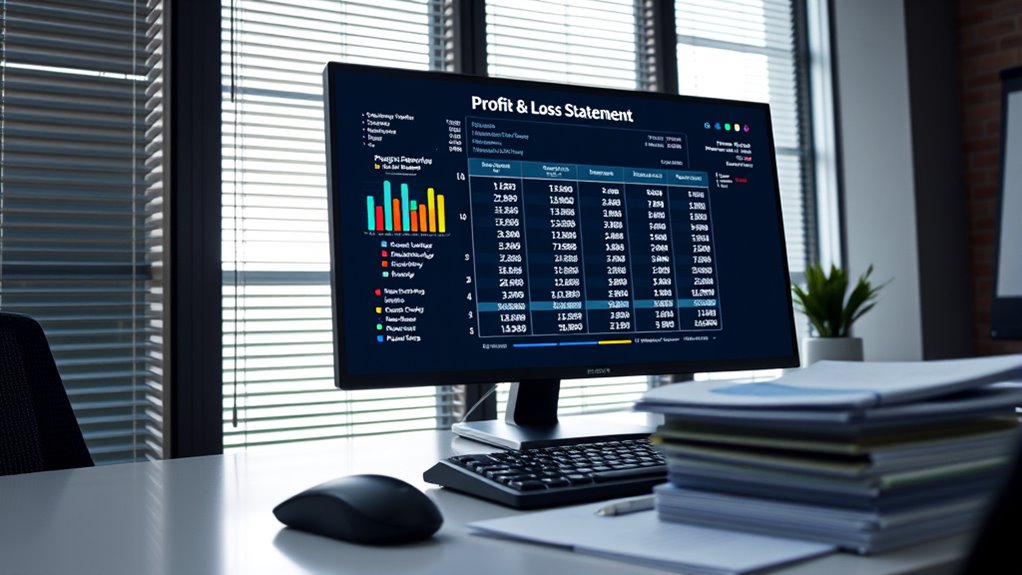To understand a P&L statement, focus on the structure: revenue at the top and expenses below, which show your company’s income and costs over a specific period. Look at gross profit, operating income, and net income to gauge efficiency and profitability. Pay attention to key metrics like profit margins and expense ratios to identify strengths or areas for improvement. If you keep exploring, you’ll discover how these figures reveal your business’s overall financial health.
Key Takeaways
- Start by examining total revenue at the top to understand income generated.
- Review expenses below revenue to see costs that impact profitability.
- Calculate gross profit by subtracting cost of goods sold from revenue to assess efficiency.
- Look at net income at the bottom to determine overall profitability after all expenses.
- Analyze key metrics like profit margins and expense ratios to evaluate financial health and trends.
Understanding the Structure of a P&L Statement

A Profit and Loss (P&L) statement, also known as an income statement, shows a company’s financial performance over a specific period. It’s typically organized into sections that provide a clear view of how the business earns and spends money. You’ll see revenues at the top, which represent total sales or income generated. Below that, expenses are listed, including costs like salaries, rent, and supplies. The difference between revenues and expenses is the net profit or loss. The structure often concludes with the net income figure, giving you a snapshot of the company’s profitability. Understanding this layout helps you quickly grasp the company’s financial health and identify where money is coming in and going out. Additionally, knowing the structure of a P&L statement can help you interpret the impact of various factors like cost management and revenue streams on overall profitability.
Differentiating Revenue and Expenses

Understanding the difference between revenue and expenses is essential for interpreting a P&L statement accurately. Revenue is the income your business earns from sales or services, while expenses are the costs incurred to run your operations. To differentiate them, consider:
- Revenue is generated from primary business activities, like sales or subscriptions.
- Expenses include costs like wages, rent, and utilities necessary to support those activities.
- Revenue increases your net profit, whereas expenses decrease it.
- Recognizing these distinctions helps in cultivating digital creativity and making informed financial decisions.
Analyzing Gross Profit and Operating Income

Once you’ve identified your revenue and expenses, the next step is to analyze your gross profit and operating income. Gross profit shows how efficiently you produce and sell your products or services, calculated by subtracting the cost of goods sold (COGS) from revenue. A higher gross profit indicates better production efficiency. Operating income, on the other hand, reflects your profitability after deducting operating expenses like salaries, rent, and utilities. It reveals how well your core business is performing before considering interest and taxes. Comparing these two figures helps you evaluate operational efficiency and cost management. Look for trends over time—rising gross profit and operating income signal strong performance, while declines may highlight areas needing improvement. This analysis provides insight into your business’s fundamental financial health. Additionally, understanding the role of diversification strategies can help improve overall stability and mitigate risks.
Interpreting Net Income and Profitability

Interpreting net income and profitability gives you a clear picture of your business’s overall financial success. It shows whether your company is truly generating value after covering all expenses. To understand this better, consider these key points:
Understanding net income and profitability reveals your business’s true financial health.
- Net Income: The bottom-line profit after taxes and all expenses, indicating overall profitability.
- Profit Margin: The percentage of revenue that remains as profit, helping you compare performance over time or against competitors.
- Trend Analysis: Observing changes in net income across periods reveals growth or decline patterns.
Using the P&L Statement for Business Insights

The P&L statement is a powerful tool for gaining actionable insights into your business’s financial health. By analyzing key figures, you can identify trends, strengths, and areas needing improvement. For example, monitoring gross profit margins helps you understand pricing and cost control effectiveness. Comparing expenses to revenue reveals efficiency levels, guiding budgeting decisions. Use the table below to interpret common metrics:
| Metric | Business Insight |
|---|---|
| Gross Profit Margin | Pricing strategy and production efficiency |
| Operating Expenses | Cost control and operational efficiency |
| Net Profit Margin | Overall profitability and financial stability |
| Revenue Growth | Business expansion and market demand |
| Expense Ratios | Cost management effectiveness |
Regularly reviewing these metrics enables you to make informed decisions that drive growth. Additionally, understanding cost control and operational efficiency can help you identify areas where expenses may be reduced without compromising quality.
Frequently Asked Questions
How Often Should I Review a P&L Statement?
You should review your P&L statement regularly to stay on top of your business finances. Ideally, do it monthly to catch any issues early and track your progress. If your business is fast-changing or seasonal, consider reviewing it more often, like weekly or bi-weekly. Consistent review helps you make informed decisions, manage cash flow, and identify trends before they become problems. Stay proactive for better financial health.
What Are Common Mistakes When Analyzing a P&L?
Sometimes, you might overlook key details when analyzing a P&L, which can lead to mistakes. You might focus too much on revenue, ignoring expenses that impact profit margins. You could also compare periods without considering seasonal factors or one-time events, skewing your analysis. Additionally, jumping to conclusions without reviewing the notes or understanding accounting policies can mislead your insights, causing you to make poor business decisions based on incomplete or incorrect data.
How Do Seasonal Changes Affect P&L Interpretation?
Seasonal changes can considerably impact your P&L interpretation by causing fluctuations in revenue and expenses. You might see higher sales during holidays or certain seasons, while costs like inventory or labor may also vary. To accurately analyze, compare data across multiple periods, account for seasonal patterns, and avoid making hasty judgments based solely on short-term spikes or dips. Recognizing these patterns helps you make more informed business decisions.
Can a P&L Predict Future Business Performance?
Think of a P&L statement as your business’s weather forecast. While it doesn’t predict every storm or sunshine, it offers valuable clues about future performance. You can spot trends, rising or falling revenues, and cost patterns that hint at where your business is headed. By analyzing these signals, you gain insight into potential growth or challenges, helping you steer your company with a more informed, strategic eye.
How Do Tax Considerations Impact Net Income Figures?
Tax considerations considerably impact your net income figures because they determine how much of your earnings you keep after taxes. When you account for taxes, your net income decreases, reflecting the actual profit available for reinvestment or distribution. Understanding these effects helps you better assess your business’s financial health and plan for future growth, as taxes directly influence your bottom line and overall profitability.
Conclusion
Now that you know the basics, mastering the money mindset means making meaning from your P&L. Practice parsing profits, pinpointing profits, and perceiving patterns. With confidence, you can cultivate clarity, capitalize on insights, and create a competitive edge. Remember, reading your P&L isn’t just about numbers—it’s about nurturing your business’s future. So, stay sharp, stay strategic, and let your financial fluency fuel your success!









